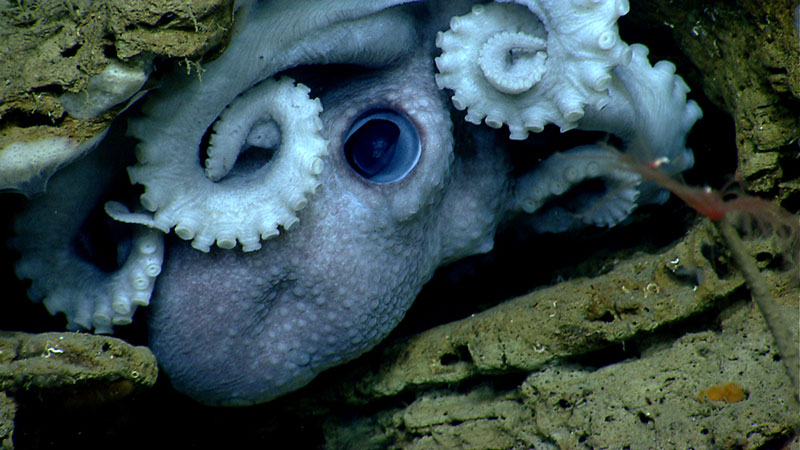
An octopus hides in the rocks in Welker Canyon. Image courtesy of the NOAA Office of Ocean Exploration and Research, Northeast U.S. Canyons Expedition 2013. Download larger version (jpg, 1.2 MB).

An octopus hides in the rocks in Welker Canyon. Image courtesy of the NOAA Office of Ocean Exploration and Research, Northeast U.S. Canyons Expedition 2013. Download larger version (jpg, 1.2 MB).
Today we had a deep dive along the southwestern wall of Welker Canyon. The dive started late because there was fishing gear along our planned dive track, and despite a plan to dive at a new target away from the lines, the gear continued to drift toward the ship and remotely operated vehicle (ROV). We waited until the fishing vessel removed the line, moved to a safe distance away from a high flier float observed after fishing gear was removed, and then continued deployment of the ROV to the seafloor. While our new track was off the planned waypoints, it still proved to be a very interesting dive. The track started at the base of a wall and transited up a steep slope and around a promontory. The track continued up a sedimented slope, until we reached a ledge. We then changed course and descended back down the wall. The beginning of the dive was characterized by high diversity of corals, including Anthomastus, bamboo (Kerotoisis), Paramuricea, cup corals, and Acanella. We also observed another purple coiled egg mass, possibly from a nudibranch. Along the sedimented slope, we observed extensive colonies of Paramuricea with scattered xenophyophores throughout. The steep slope examined in the later part of the dive included multiple large colonies of Bathypathes-related, cup corals, Paragorgia, octopuses, sea pens, and encrusting zoanthids. Several caves, deep concavities or amphitheater shaped curves in the rock wall, clear erosional features were observed. Octopuses were often observed in these depressions and under large rock ledges. There were multiple areas where a thin rock layer failed and revealed clean rock faces. We also observed some large, deep “burrows” or “pipes” of mysterious origin. A few different fish species were encountered at the base of the wall, including cf. Gaidiropsarus, oreo, a skate, and an Antimora. At least 17 species of corals were observed throughout the dive, including Bathypathes, Bathypathes-related, Parantipathes, Anthomastus, Paramuricea, Keratoisis, Solenosmilia, Paragorgia, Acanella, Swiftia, Acanthogorgia, unknown octocoral, Clavularia, Anthothela, sea pen, Thourella, and Radicipes. At the end of the dive, we observed an enormous anemone, more than 30 centimeters in diameter, with a polychaete attached to a tentacle. The ROV left bottom at 2130 UTC from a depth of 1,407 meters. Midwater transects were conducted during ascent.